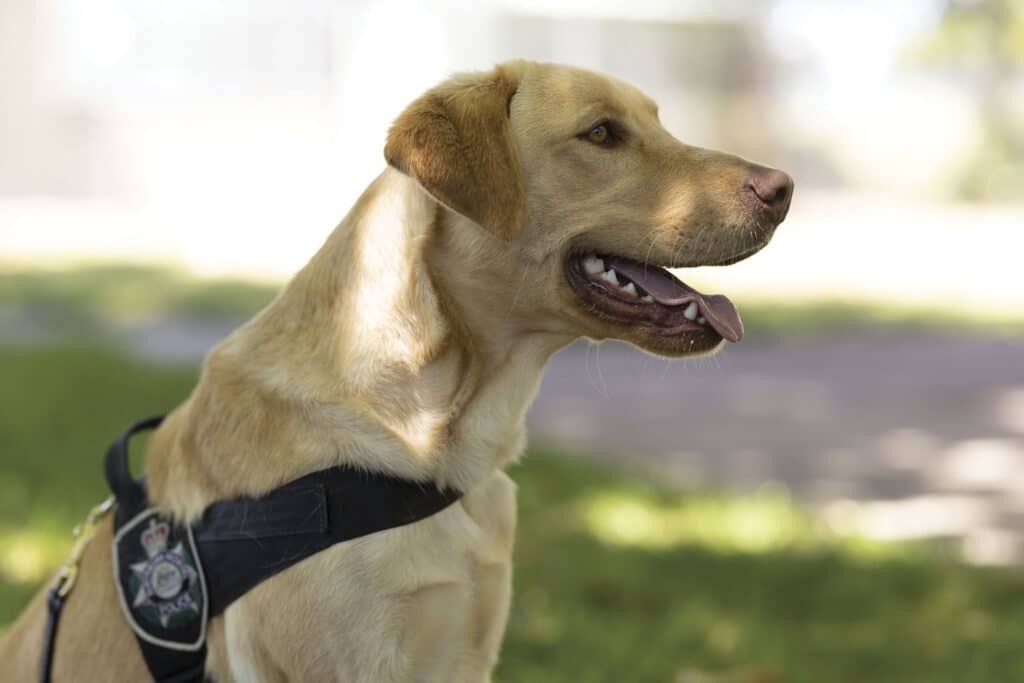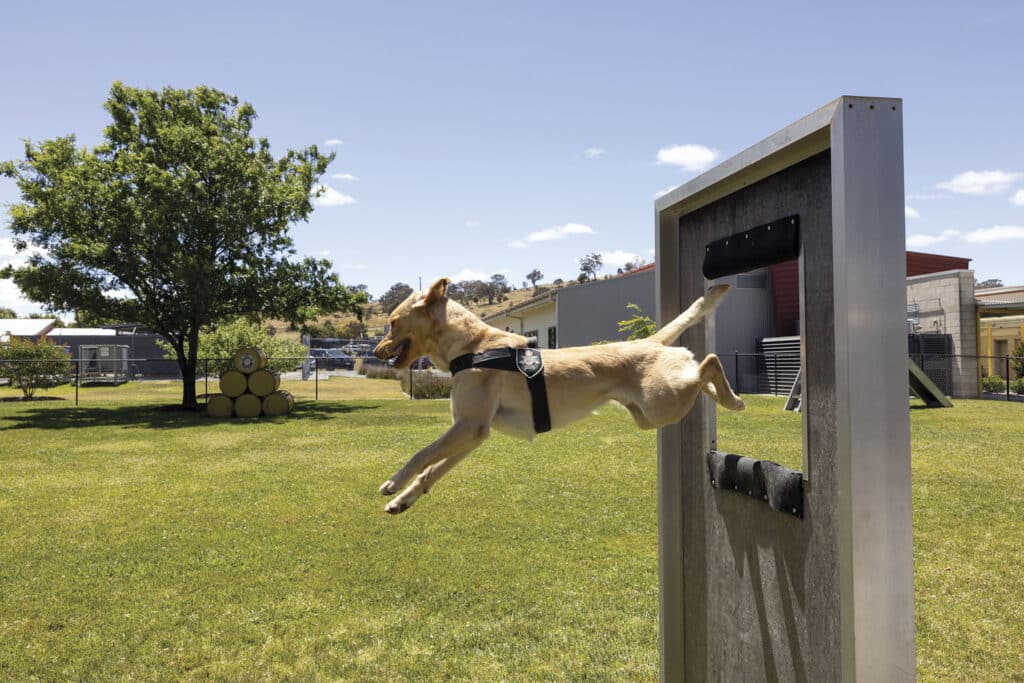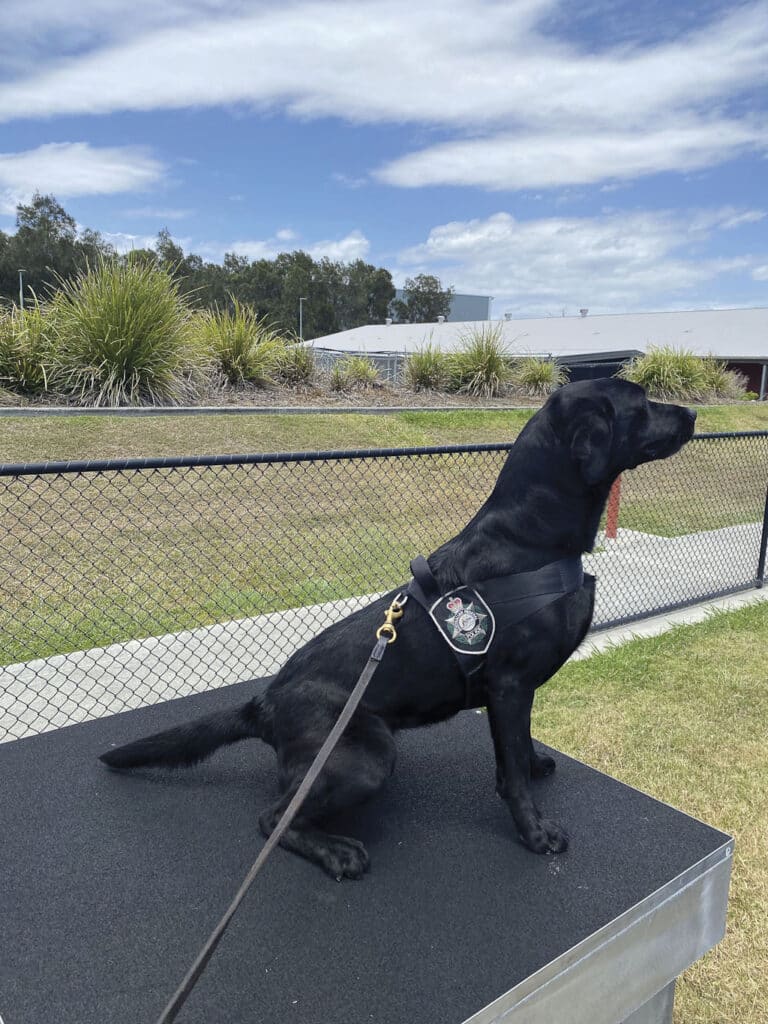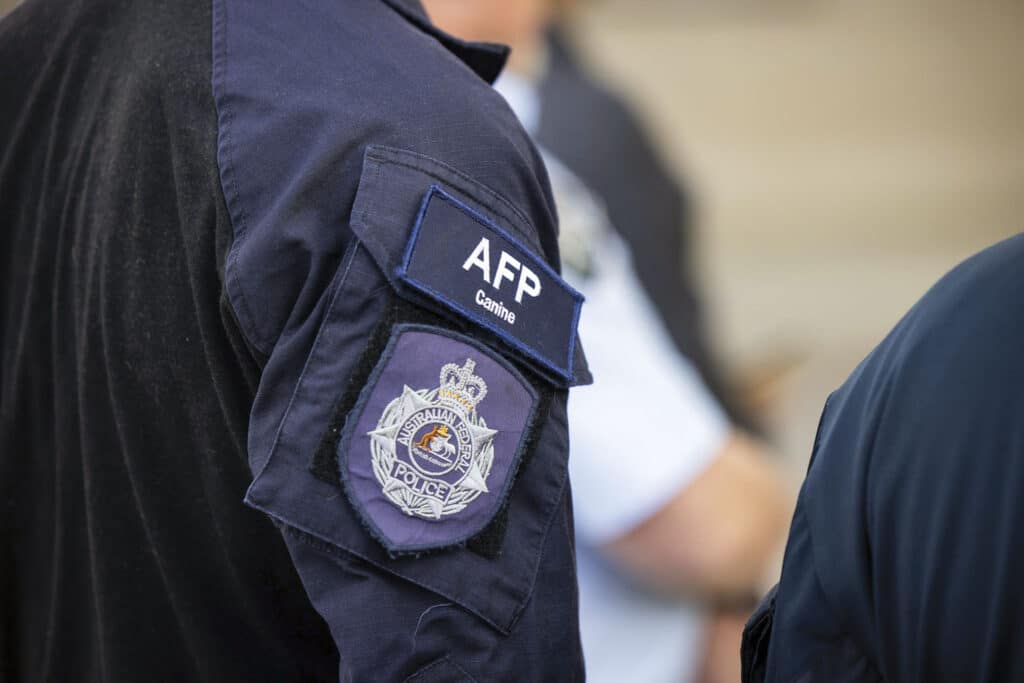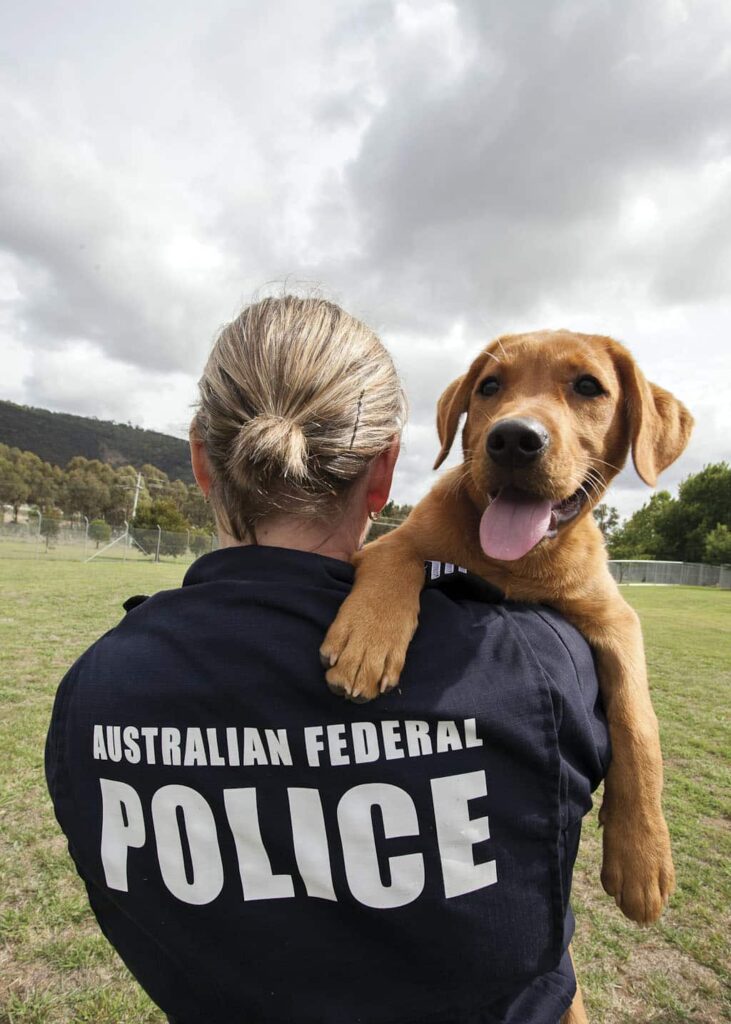CRIME
On the Scent of a Crime – A scenario where dogs really rule!
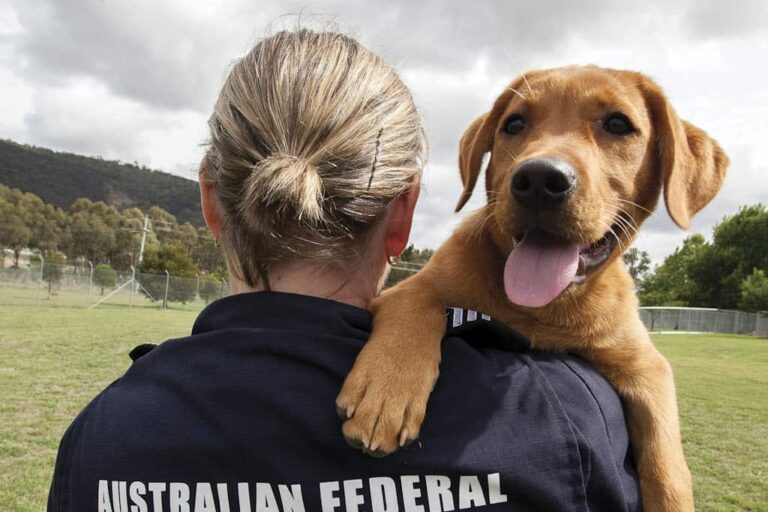
WORDS: Detective Sergeant Suzie Nicholas- Australian Police Journal -www.apjl.com.au PHOTOGRAPHY Australian Federal Police
THE CHALLENGE
As electronic devices get smaller and faster, and would-be criminals attempting to cover their tracks get smarter, law enforcement faces unique challenges in identifying and collecting hidden storage devices containing critical evidence.
Criminals increasingly use devices with memory storage, such as mobile phones, SIM cards, USBs, SD cards and hard drives when they plan and carry out their criminal activities. Many of these devices can also contain harmful material like malware, sensitive content and intellectual property.
This challenge affects investigations across all crime types, including counter-terrorism, espionage and foreign interference, child exploitation, organised crime, fraud and cybercrime. This is why addressing it has become more critical than ever.
HOW IT BEGAN
In 2016 the Connecticut State Police, in conjunction with studies undertaken by the Auburn University in Alabama, publicised that they were the first agency in the world to have trained a dog with the ability to detect electronic storage devices.
Dogs had previously been trained and used to find mobile phones, primarily in correctional facilities, detecting the odour emitted from the lithium batteries.
Connecticut State Police shared their electronic storage detection capability with other agencies in the USA, thus imprinting this battery odour on the first dog by the Federal Bureau of Investigation (FBI).
At the time, there were only seven dogs in the world trained for this kind of detection. The dogs were imprinted on chemicals located on the electronic components of storage devices – triphenylphosphine oxide (TPPO) and hydroxy cyclohexyl phenyl ketone (HPK).
The dogs trained to find the electronic storage devices began to have remarkable success across all streams of investigations in the USA, detecting devices secreted in all sorts of places – inside vehicles, in walls and even locating a USB in a box of staples buried in a cabinet.
WORD SPREADS
In 2017 Connecticut State Police shared information about this unique capability with the Australian Federal Police (AFP).
The AFP National Canine Operations began to conduct further research, including whether there was an appetite in Australia for a detection dog capability that could detect electronic storage devices.
Consultation between various functional areas within the AFP showed a high demand for the Technology Detection Dog (TDD) capability, particularly within the child exploitation, counter-terrorism, and technology-enabled crime portfolios.
STUDY TOUR
In April 2019 two members from AFP National Canine Operations travelled to the USA to observe the TDD capabilities of multiple law enforcement agencies. This established the proof-of-concept for the AFP to pursue this capability, following some initial scepticism as to whether dogs could actually detect mass storage devices. The visit also enabled the sharing of training methodologies, deployment techniques and lessons learned since the TDD capability conception.
It was evident that technology detection would be the most challenging capability the AFP National Canine Operations had delivered to date.
THE PLASTIC WORLD
These devices, constructed with volumes of plastic and other common metals, would need to be detected in and among a plastic world. The dogs selected would need the cognitive ability to generalise these devices from other similar plastics in their search area – or plainly, they would need to find a specific needle in a needle stack.
A training program was developed to amplify these target device odours while being able to ‘proof-off’ the similar common odours that are in our everyday world. The dogs selected had to possess the work ethic to withstand thousands of verification exercises, repeating very intricate exercises where they would have to identify the correct target odour without indicating to other non-target odours.
AFP CANINE PROGRAM
The AFP National Canine Program currently manages more than 100 dogs. This includes general-purpose dogs and dogs in training and detection dogs trained in the disciplines of explosives, firearms, currency, drugs, and technology detection.
The canine olfactory system is more complex and highly developed than that of humans, with a dog able to detect odours on a threshold of up to 100,000 times that of a human.
It is this premise that AFP National Canine Operations relies upon when training the detection dogs that help protect Australia and its national interests. Dogs are an ideal detection tool as they are agile, inexpensive, equipped to search for an odour as opposed to a physical object, and have a proven record of detecting slight target odours in a wide range of operational environments.
THE ELITE
After observing the electronic storage device detection dogs overseas, it was evident that the dogs selected for the TDD capability had to be in the top-tier of detection dogs. All the dogs chosen had to possess specific traits such as an uncompromised health record, high drive, environmental robustness, endurance for rapid and repetitive learning,
When selecting the handlers for the TDD capability, National Canine Operations chose members who were experienced dog handlers. This is because the methodology in deploying the dogs is more involved and detailed than that used when deploying detection dogs in other capabilities, and a thorough understanding of the complexities of dog handling is required in the TDD discipline.
SEEK, AND YOU SHALL FIND
A TDD handler is much more reliant on intelligence than dog handlers for other disciplines, such as explosives or drugs, due to the nature of the items they seek. Some of the information the handlers will obtain prior to searching is common sense, like the type of items and precisely what it is they are searching for, but they will also need to know things like the size and type of search area (for example, whether it is a large or small residence or a business office), the offence type and any history of offending, and, if search warrants have been conducted before, the concealments of any items located. There is an onus on handlers in the TDD capability to keep at the forefront of intelligence, like concealment methods and any developments in the types of technology devices being used.
At the search location, TDD teams are deployed after a hand search by the investigators, which is different from deployment procedures for other detection dog capabilities where the dogs search before the investigators search.
After the search by investigators is complete, the TDD handler has all the technology-based items already located moved out of the search area, and only then will the TDD team commence their search with a focus on items that may have been concealed.
GEORGIA
In late 2019 the AFP National Canine Operations, now armed with the information learned from overseas, successfully trained a pilot TDD – a small, black female Labrador by the name of Georgia.
Georgia was born on 23 October 2017 and graduated as an AFP detection dog in February 2020.
Her characteristics and personality encompassed everything the program was looking for in a detection dog and, from the commencement of the project, Georgia exceeded all expectations.
In her first four months of operational deployment and working in harmony with her handler, Leading Senior Constable Scott Lewis, TDD Georgia located 83 devices (including mobile phones, USBs, SIM cards, SD cards, hard drives and smart watches) over 14 different search locations.
The key factor in these results was that she located these items after hand searches of the locations had been conducted.
CASE STUDY
On Thursday 17 December 2020, Leading Senior Constable (LSC) Scott Lewis from the AFP National Canine Operations team in Brisbane received a call from an AFP member on behalf of the Queensland Police Service (QPS). He was asked if he and TDD Georgia could assist in locating an electronic monitoring bracelet. After obtaining more information about the device, LSC Lewis determined that because it contained a small amount of memory storage hardware, it may be possible for TDD Georgia to locate the bracelet, despite never having trained on such a device.
LSC Lewis obtained more intelligence from the investigators, who said that the tamper alarm on the device had been activated the night before in the search area and that the male had removed it and discarded it somewhere within the vicinity. LSC Lewis broke the search area up visually into grids and began a systematic search of the area with TDD Georgia. LSC Lewis and TDD Georgia worked systematically with and around the police hand searchers for over two hours; the first time they had conducted a prolonged and detailed search in that type of environment.
NEVER SAY DIE
With less than an hour of daylight left, LSC Lewis was determined to continue the search for the electronic monitoring bracelet with TDD Georgia. He had already been given good coverage of the suspected GPS data location and chose to extend his search area beyond that. He and TDD Georgia went back to work, concentrating on areas immediately outside the known scope and focusing on areas that could be accessed on foot.
LSC Lewis moved closer to TDD Georgia and saw what appeared to be a black plastic strap buried in the dirt. Closer inspection revealed that it was the electronic monitoring bracelet that the team had been searching for. LSC Lewis called the police investigators and guided them to the location. The black piece of plastic that he had previously picked up on the track proved to be the backing plate of the electronic monitoring device.
The bracelet and backing plate were placed in evidence by the attending investigators. The electronic monitoring bracelet was crucial to the subsequent double homicide investigation and contained evidence of the subject’s movements, which could be downloaded from the device.
SO… IT GROWS
After the success of Georgia, National Canine Operations determined that the capability was valuable and something that could be progressed and enhanced over time. A proposal was submitted under a Proceeds of Crime Application process, and a funding amount of $1,300,853 staged over a four-year period (2020-2024) was granted to the AFP from the Confiscated Assets Account to develop and enhance a TDD capability targeting concealed technical devices. This funding was to procure and train four TDDs with the capability to discover and collect evidence that would otherwise be unable to be used.
It was during the Federal Budget announcement in May 2021 that the AFP was provided $31.6 million in new funding investment for frontline child protection efforts to deliver the initiatives under the First Commonwealth Action Plan. This included procuring and training eight TDD teams to target concealed technical devices that may contain illicit content when executing search warrants.
OPERATION IRONSIDE
In June 2021 the dogs played their role in the highly publicised AFP Operation Ironside. At that time there were only three TDDs in the National Canine Program and between them, they travelled to and attended 12 Ironside tasks across the country. They located 80 items, including mobile phones, USBs, SIM cards and SD cards. Before Operation Ironside, the dogs had attended five or six search warrants between them per month, so this was a significant increase in the demand for the capability.
TECH DOG WORLD
In September 2022 AFP National Canine Operations hosted a two-day TDD Symposium in Canberra.
The event brought together canine specialists from a host of agencies, including AFP; Australian Border Force; ACT Corrective Services; Australian Defence Force; Corrective Services NSW; National Office for Child Safety; New South Wales Police Force; New Zealand Police; Northern Territory Police Force; Queensland Corrective Services; South Australia Police; Victoria Police; and Western Australia Police Force.
These relationships result in shared concurrent technical knowledge and research, afford probity checks into each partner’s training development, methodology and practices; and serve to both build extended relationships beyond pure technical canine capability requirement and open doors to other international agencies with a shared interest in the field of the TDD capability.
THE SCIENCE
Common ground is also found between AFP National Canine Operations and the scientific community. International engagement often includes both Canine and Forensic capabilities in studying the ‘headspace’, or the type and volume of molecules that these technology items break down into odour. Similar studies are being conducted around the world in conjunction with the National Police Corps in the Netherlands, as well as the United Kingdom Law Enforcement.
CHILD PROTECTION
One of the areas where the TDD capability has made its most significant impact is that of Child Protection Operations, historically a crime type where detection dogs have not been able to be used. This is changing now, with TDDs being increasingly deployed on search warrants, looking for specific items that may contain illicit images and other evidence. Over 50 per cent of the 160 searches conducted by the TDD teams since January 2021 have been for Child Protection Operations and Joint Anti-Child Exploitation Teams (JACET) around Australia, where the dogs and handlers have made their respective marks.
Claire Arnold, a Team Leader in Child Protection Operations in Brisbane, said, “The Technology Detection Dogs have been a great addition to our search warrant teams. They have been invaluable in helping us locate small or concealed items that have been missed by the human searchers.
“As a bonus, we get to sneak the occasional pat – they lift the mood of the team as soon as they enter the premises.”
Detective Sergeant Bob Rose from ACT Policing said, “The ACT Joint Anti-Child Exploitation Team (JACET) regularly utilises the services of senior TDD teams in relation to the execution of S.3E Crimes Act 1914 search warrants in the ACT.
“Offenders who access child abuse material online often store their illicit images on micro-SD and SD cards, and then further secrete them within their homes. Regularly, with the most thorough search conducted by police members well versed in the size of the storage devices, the TDD team would find memory cards hidden within furniture components, or in well-camouflaged locations.
TODAY
Currently, AFP National Canine Operations has 13 TDDs working around the country. Besides Georgia, there are four dogs under the Confiscated Assets Account funding model, and eight dogs under the National Strategy to Prevent Child Sexual Abuse.


